
Professional silicones sealants
Buy your silicones from the specialist dealer and benefit from selected quality products. Our silicones are used by professionals in construction and industry. At S-Polytec we offer premium silicones in popular colours at affordable prices. Simply choose your desired colour and quantity in our online shop and get your silicones delivered to your home.
- all our silicones are UV and weather resistant and ready for use outdoors as well as indoors
- our entire range of silicone sealants is checked for constant quality during the entire manufacturing process
- benefit from the scaled pricing on all our adhesives and silicone sealants
Smoothing agent - S-Polybond FUGENglatt 500ml
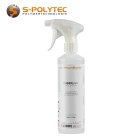 €6.90 / pcs
€6.90 / pcsIncl. 19% Tax
Alkoxy silicone transparent (Colorless)
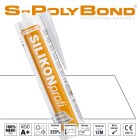
Alkoxy silicone RAL7016 (Anthracite grey)
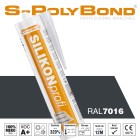
Alkoxy silicone RAL9010 (Pure white)
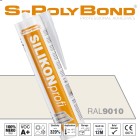
Alkoxy silicone RAL8016 (Mahogany brown)
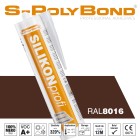
Professional cartridge press GUDFOR Heavy Duty
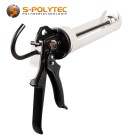 €19.90 / pcs
€19.90 / pcsIncl. 19% Tax
Robust cartridge press POINT High Tack
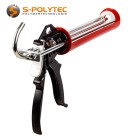
Cartridge gun FOME FLEX Black Edition
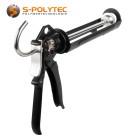 €11.90 / pcs
€11.90 / pcsIncl. 19% Tax
Parasilico AX Plastics T transparent
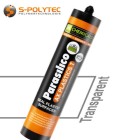 from €12.95 / pcs
from €12.95 / pcsIncl. 19% Tax
Silicone transparent (colorless)
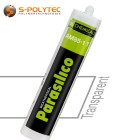 from €5.25 / pcs
from €5.25 / pcsIncl. 19% Tax
Silicone RAL 9010 white (pure white)
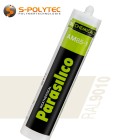 from €5.25 / pcs
from €5.25 / pcsIncl. 19% Tax
Silicone RAL 9003 white (signal white)
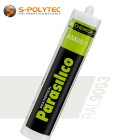 from €5.25 / pcs
from €5.25 / pcsIncl. 19% Tax
Silicones from S-Polytec - Best quality ✓ UV-resistant ✓ Permanently elastic ✓
Silicones - more than just a sealant
Silicones are available in innumerable designs and colours and are ideal for a wide range of applications because they can be processed without the need for large aids and are generally very easy to work with. Among the most common applications are sealing, waterproofing or even gluing. However, not all silicones are equally suitable for the different applications, because it depends not only on the intended use but also on the substrate on which the silicone is to be applied. Particularly when sealing and waterproofing, care should be taken to ensure that the silicone sealant is suitable for the material and does not attack it and also adheres well to it. With regard to the elasticity of a silicone, about which the technical data sheet provides information, it should also be checked whether the elasticity of the cured silicone is sufficient for the intended use. Particularly with the less expensive silicones, lower values must be expected here, which has a particular effect on the durability of a silicone joint under mechanical stress. The colour consistency of cheap silicones will also have to be reduced, because the even pigmentation of a silicone can vary regardless of the colour tone. This is especially true if the raw material is not kneaded with extreme care during production.
In our online shop, we offer you professional silicone sealants for a wide range of applications in all imaginable colours. When selecting our product range, we not only pay attention to the highest quality for a maximum service life of the silicone joints and sealants, but also to the fact that they can be applied to almost all surfaces without attacking the surfaces. For this reason, we only offer you silicones on a neutral-cross-linking alkoxy basis, which is also characterised by a barely perceptible odour during processing and curing. Although neutral silicones are generally considerably more expensive than silicones on acetic acid-curing basis, we are able to purchase our silicones at very favourable conditions due to the direct purchase from the manufacturer and no costs for the intermediate trade and due to the very large purchase quantities. We are happy to pass these price advantages on to you.
TIP: Save money and benefit from our generous quantity discounts when buying our high-quality silicones.
Seal with Silicone
Silicones are an adhesive and sealant and are primarily used in the trade to seal buildings. Especially when different building materials or even separate buildings are adjacent to each other, the connection joint is sealed with a silicone of matching colour. Silicone is most frequently used for the airtight sealing of windows and doors, in which the joint between masonry and window profiles made of plastic, aluminium or wood is sealed in such a way that an unwanted draught is avoided, which has a particular effect on energy efficiency in terms of thermal insulation. In addition, construction connection joints between two buildings or expansion joints are also sealed with a silicone to prevent the penetration of ambient moisture from the air. Due to the high elasticity of our high-quality silicones, permanently elastic silicone joints with a long service life are possible, even for silicone joints on different building materials with differing thermal expansion.
Another area of application of sealing with silicone is in the field of interior design. Silicones are used in all damp rooms, such as bathrooms or WCs, to seal the joints of wall tiles and floor tiles. Also the sealing of plinth tiles on tiled floors, laminates or natural stone floors is carried out with a silicone in the appropriate colour to achieve an elastic connection between floor and wall plinth. This visually enhances the connection joint and at the same time prevents the sound from being transmitted to the building wall by the occurrence, pounding or even the backs of furniture, thus making it perceptible throughout the building.
In order to seal building connection joints or expansion joints, as well as windows, doors or panes, sufficient UV resistance and light fastness is absolutely essential. To ensure that our silicones can also be used permanently in outdoor applications, all our silicones are weatherproof, so that they meet all requirements in all weather conditions without affecting the durability of the silicone joints.
- Silicones are ideal for sealing expansion joints in buildings for effective structural waterproofing
- Silicone can be used to seal connection joints between different building materials (e.g. wood and concrete).
- Sealing windows, house and patio doors contributes to improving energy efficiency
- Silicone joints between floor and skirting tiles create a visually more attractive transition
- Our silicones are weatherproof and can be used for sealing indoors and outdoors
- and many more
TIP: If you use silicone for sealing, you should bear in mind that the silicone joints cannot be painted over with conventional wall paint.
Seal with Silicone
In contrast to sealing with silicone, sealing with a silicone sealant serves to create a watertight or even airtight connection between two individual elements. This is also the case with sealing, but when sealing, the emphasis is on making the joint watertight to prevent damage from escaping or penetrating water.
While silicone joints on tiles are used to seal the structure, in barrier-free showers, for example, bathtubs, shower trays or even ground-level drains are sealed with a silicone to prevent water from passing unhindered through the gaps into the masonry or screed and causing damage. The demands on a silicone are quite high, because it must be permanently elastic and adhere to almost all surfaces, such as ceramics, tiles, plaster, natural stone or even glass. In addition, a silicone for sanitary applications must be waterproof and resistant to high humidity. Furthermore, a silicone in damp rooms should always have mould-inhibiting properties so that the silicone joints do not become mouldy over time and need to be renewed.
Sealing of aquariums, terrariums for the private sector, but also for large pool systems in zoos can also be carried out just as well with a silicone sealant. The same applies to swimming pools, where the connection joints and overflow gutters are sealed with silicone so that the water only reaches where it is supposed to. Another common use of silicone as a sealant is to seal glazing. This can be conservatories, terrace roofs or glass panes made of plastic or real glass. Particularly for outdoor applications, it is extremely important that the silicone has very good UV and weathering resistance so that the silicone joints do not become brittle due to UV radiation and leakage occurs. For this reason, all our silicones have outstanding resistance to UV and weathering.
- Our silicones are mildew-inhibiting and are used for sealing sanitary facilities
- Silicones bond and seal in one step and are therefore very suitable for aquarium sealing
- Our silicones are solvent-free and can be used to seal plastic glazing
- Our UV-resistant silicones are ideal for sealing patio roofs and conservatories
- Sealing cracks in tiles or pipes is quick and easy with silicone sealants
- and many more
TIP: To seal with silicone, the silicone must be suitable for the material(s) and adhere well to it.
Bonding with silicone
Silicone is not only excellent for sealing and waterproofing, but can also be used very well for bonding. It should be noted, however, that silicones are mainly suitable for bonding smaller or lighter objects, such as ceiling end strips, skirting boards or cable ducts, because although silicones do have a fairly high adhesive power, they are at a disadvantage compared to MS polymers. These are characterised by a very high initial adhesion and a much higher adhesive strength, which is a decisive advantage especially when bonding objects with a higher weight or smaller adhesive surfaces.
The biggest advantage of bonding with silicones is that the bonds are permanently elastic. This has a particularly positive effect when bonding materials with different coefficients of thermal expansion. For example, when bonding wood and metal in order to attach aluminium end profiles to wood panelling or plastic skirtings on walls and floors.
Our silicones are all neutral cross-linking and cure on contact with air humidity. When bonding with silicone, it is therefore recommended that the silicone sealant is not applied over a large area or in a ring shape, but in slight waves with a certain distance between each other. Otherwise the curing of the silicone can be significantly delayed or even completely prevented, which has a particular effect on the fixing time of the object to be bonded.
- Aluminium or plastic end profiles can be glued very well with silicone
- Silicone can be used to glue single tiles or skirtings e.g. to repair damages.
- Silicones are very suitable for gluing ceiling finishing strips, e.g. stucco strips made of polystyrene.
- Silicone can be used to glue and seal end strips to the kitchen worktop
- Silicone is perfect to lay cable ducts by gluing to hide disturbing cabling
- and many more
TIP: Silicone is not suitable for bonding polyolefin such as polyethylene or polypropylene. PTFE cannot be bonded with silicone either.
What is Silicone?
The composition makes the difference
Silicone is not the same as silicone and so the sealants are not only differentiated according to their areas of application, but also according to their different compositions. Furthermore, not only are silicone sealants available on the market in standard cartridges on a one-component basis, but also special silicones that have two components. These usually consist of the base component - i.e. silicone compound to which additives are added to achieve special properties and, as the second component, a pour point activator which initiates the cross-linking process.
While two-component silicones are mainly used in industry for sealing, waterproofing and bonding, the well-known one-component silicone sealants are generally used by craftsmen and households. However, a distinction is also made here according to areas of application, because the requirements placed on a silicone vary greatly depending on the intended use. For sanitary applications, silicones treated with fungicides or biocides are often used, as these have mould-inhibiting properties. In addition, there are also silicones that can withstand very high temperatures or have improved properties in terms of elasticity after curing. In order to be able to use silicones in a wide variety of colours, most silicones are also enriched with colour pigments.
The conventional silicones, as we know them from the hardware store or our online shop, are divided into two different types.
On the one hand, there are silicones that split off acetic acid during curing. These are very often described as acetic cross-linking and show a clearly perceptible smell of acetic acid during use and curing, which, however, disappears with time. Such silicones have the advantage that they adhere very well and cure faster. Depending on the joint width, the curing time is only 4 - 6 hours. However, acetic acid has the disadvantage that the silicones should not be used on all substrates, because the acid can attack the substrates. Therefore, do not use acetic acid-curing silicones for natural stone, marble or non-ferrous metals (e.g. aluminium, copper, zinc, lead, cast iron, etc.).
The second widely used type are neutral-cross linking silicone sealants, which are not only characterised by a less obtrusive odour. Although these silicones have the disadvantage of curing much slower at around 2-4mm per hour and are also usually more expensive, they can also be used to seal natural stone or the non-ferrous metals already mentioned, unlike the acid-cross linking sealant.
Characteristics of our silicones
Our silicones are characterised by a multitude of positive properties. All silicone sealants in our online shop are neutral-cross linking silicones on an alkoxy basis, which are characterised by a weak, less noticeable odour. The very good flow properties contribute to the fact that the silicone can be processed very well and also penetrate into joints with small gap widths. In addition, the silicone can be smoothed out effortlessly due to its excellent, pasty viscosity. As a neutral sealant, it can be used without hesitation on sensitive surfaces where acetic-curing silicones are not recommended. For example, for sealing plinth tiles made of marble or natural stone, or for sealing construction connection joints of aluminium window frames. So that our silicones can also be used for sealing in damp rooms and sanitary facilities, all our silicones have mould-inhibiting properties.
All our silicones are frost-resistant and are suitable for use at temperatures between -50°C and +150°C. This means that the silicones are frost-resistant and can be used outdoors without hesitation, even in regions where outside temperatures fall well below freezing point. In addition, our silicones are UV and weather resistant and are characterised by very good light fastness, so that even our coloured silicones do not fade or discolour.
How does silicone cure?
In contrast to two-component silicones, in which a pour point activator initiates the curing process, the commercially available silicone sealants on a one-component basis cure by contact with the ambient humidity. This means that the surface of the applied sealant should have sufficient air contact to ensure a continuous and even curing.
In most cases, curing by skin formation starts after a few minutes and then, depending on the joint thickness and width, continues to cure until the silicone joint is completely cured. Depending on the concentration of the various ingredients, the duration of skin formation can be delayed, so that sealing over longer distances is possible without the need for rapid smoothing. However, the skin formation as well as the curing of a silicone depends on the ambient temperature and the concentration of relative humidity and can therefore vary considerably.
With our silicones, the skin formation time is approx. 25 minutes at an ambient temperature of +25°C and a relative humidity of 50%. Higher temperatures accelerate the process of skin formation, as does higher humidity. The curing speed of our silicones is between 2.5mm and 3mm per 24 hours, depending on the environmental variables, and is thus in the typical range for a neutral-curing silicone.
Basically, silicones should not be processed if the temperatures are below +5°C or above +40°C. After curing, however, our silicone can be used permanently at temperatures between -50°C and +150°C without hesitation. For higher continuous operating temperatures, we can also supply high temperature resistant silicones on request.
How to use silicones correctly?
Bonding, sealing or caulking with silicone basically requires the same work steps. Before the silicone is applied, the corresponding substrate must be properly cleaned. Any protrusions of tile adhesives, remains of old silicone joints or even stubborn dirt must be completely removed so that the silicone can adhere to the surface safely and permanently. It is also important to remove dust, grease and cleaning agents from the substrate, as this can also have a negative effect on the quality and durability of the joint. In addition, the area where the silicone is to be applied should be dried beforehand with a lint-free cloth.
A silicone gun is required to process single-component silicones. It does not matter whether it is hand-operated, battery-operated or operated by air pressure. For silicones in standard cartridges, simple silicone guns from the DIY store can be used. For more regular use, however, we recommend our professional silicone gun, which, thanks to its high transmission ratio, allows easy handling without fatigue even during prolonged use. It is also advisable to have a sharp knife at hand for cutting the cartridges and shortening the cartridge tips. For smoothing the silicone joints, wooden sticks (e.g. ice cream sticks) in different sizes and radii can be very useful. Alternatively, there are also professional joint smoothers to which the silicone does not adhere. Special smoothing agents that improve the result of the joint, as well as a container for excess silicone or an old rag for cleaning the cartridge tip, the joint smoother or the hands, also make the work of sealing much easier.
Also before processing, care should be taken to ensure that the ambient temperature is neither too high nor too low, so that the silicone can be processed well. Our silicones can be processed at temperatures from +5°C to +40°C. At temperatures above this, the duration of skin formation can be too short, so that the silicone cannot be smoothed properly. At temperatures below +5°C, it is quite possible that the silicone no longer has sufficient elasticity, which affects the adhesion, so that the joint may not seal properly.
When sealing the joint itself, the tip of the cartridge should be cut so that it is slightly larger than the joint itself. For joints with a high depth, as is often the case with construction connection joints or expansion joints, the depth should be filled in advance with a round sealing tape and limited, so that no unnecessary silicone has to be applied to the joint. During application, care should be taken to ensure that the silicone always adheres to both sides of the delimiting surfaces. This is also known as two-flank adhesion. Avoid that the silicone comes into contact with the substrate, because this faulty three-flank adhesion will still result in a tight seal, but this can have an extremely negative effect on elasticity or sound insulation. In addition, you should always apply enough silicone during sealing, so that any excess silicone can be removed with a joint smoother or wooden stick. Before stripping, the freshly applied silicone, as well as the selected stripping aid, should be wetted with a special smoothing agent. This makes stripping much easier and thus contributes to an improved result in the appearance of the sealant. Often, water-rinse agent mixtures are used for this purpose, but the soap-containing solution can lead to a reduction in the flank adhesion of the silicone sealant. With our smoothing agent S-Polybond FUGENglatt, on the other hand, this risk does not exist, so that the silicone joints can be smoothed more easily without impairing the adhesion.
As a rule, stripping with a joint smoother is sufficient, so that the sealant only needs to harden. In some cases, however, adhesion to the substrate can be improved by lightly pressing and smoothing with a finger.
TIP: Depending on the depth and width of the joint, always allow the joint to harden sufficiently long before subjecting it to mechanical stress.
Lifetime of silicone
Silicone joints belong to the so-called maintenance joints, regardless of whether they are used to seal or seal the bathtub and shower cubicle, or a construction connection joint at the front door. The service life of a silicone joint depends on many different factors, so it is advisable to check the condition of the joints at regular intervals. Depending on the quality of the silicone sealants, UV radiation, weathering or even mould can also contribute to the fact that a silicone joint needs to be repaired or renewed. Mechanical stress caused by movement can also have a negative effect on the service life of a joint. This does not refer to the different coefficients of thermal expansion of two construction materials (e.g. PVC window frames and sand-lime brick or clinker brick), because the permanently elastic sealants can easily withstand the low mechanical stress caused by expansion of the silicone joint. Rather, it is a matter of the movement of the bathtub, WC seat or even interior doors, which can have a more or less strong effect on the joint.
We only sell silicones of the highest quality, with outstanding properties in terms of UV resistance and weather resistance. In addition, all our silicones are equipped with fungicidal additives, so that even the formation of mould does not contribute to the need to renew the silicone joint after a short time.
As a further aspect that should not be neglected, the care and cleaning of silicone joints is one of the measures that have a lasting effect on the durability of a silicone joint. Not only the degree and type of contamination, but also the way in which cleaning is carried out, are factors that can have a significant impact on the durability of the sealant. Sharp objects, scouring agents or highly concentrated cleaning agents, can even damage the joints, so that in the worst case they have to be replaced.
However, when regularly cleaned with suitable agents, combined with a routine visual inspection for damage, the service life of a silicone joint is usually far longer than the average use. In most cases, the floor covering is replaced or the bathroom is renovated rather than the silicone joint having to be replaced.
The lifetime of a silicone in a closed, unopened cartridge depends on the shelf life and storage conditions and is usually around one year.
How to store silicones correctly?
Depending on the manufacturer, silicones can be stored for about 12-18 months in unopened condition if stored in a dry, cool place. At temperatures above 25°C, however, the shelf life is reduced. To ensure that a silicone can still be used, it should be checked for flow properties (also known as viscosity) and adhesion before use. If the silicone sealant can be rubbed between the fingers without clumping and shows a certain stickiness, the silicone can usually still be used without hesitation.
TIP: If a silicone sealant that has been opened is to be used again at a later date, it is important to seal the cartridge airtight so that the sealant does not harden in the cartridge. With a hard-wearing foil, which is tightly wrapped around the tip of the cartridge and fixed with adhesive tape, you prevent air from getting into the not yet cross-linked silicone. If the cartridge tip has small openings, a wood screw can also be screwed into the tip to prevent the silicone from reacting with the air humidity and curing.
Care and cleaning of silicone joints
Silicone joints are often used for sealing to prevent moisture from penetrating into the substrate. However, moisture is an ideal breeding ground for mould growth. This mainly concerns inferior silicones without fungus inhibition and can pose a risk through mould growth. Both in terms of the tightness of the joint and for health, as mould spores can cause allergies and asthma. In most cases, the affected silicone joints must be completely renewed, which is a considerable effort. Although all our silicones have mould inhibiting properties, irregular or lack of cleaning can lead to soiling on the surface of the joints, which can encourage mould to grow on the dirt.
Regular cleaning is therefore advisable and can be carried out with a cloth and a little standard citrus or vinegar cleaner. After cleaning, always make sure that the joints are also dried to prevent dirt from sticking to the wet surfaces again.
More stubborn dirt on the joints can be easily removed with a steam cleaner. The use of steam does not affect intact joints and the dirt is effectively removed by the use of heat and steam. Cleaning with a soft brush (e.g. a manual toothbrush) is also a proven method of keeping silicone joints clean. However, do not use harsh cleaners, solvents or strong acids at any time, as this can have a negative effect on the surface quality of the silicone joint. If the silicone joints are damaged by sharp objects, rubbing or incompatible cleaning agents, this can cause premature ageing of the joint. In this case, the silicone joints become brittle, which can lead to cracking and even leakage. In this case, the silicone joints should be removed and repaired with a new silicone joint.
Removal of silicone joints
The removal of silicone joints is a challenge for most people, because before the silicone joint can be renewed, the old joint must be removed without leaving any residue. In the first, rough step, the joint should be carefully cut out with a sharp knife. Afterwards residues of the adhering silicone should be removed with a profile scraper. Depending on the hardness and condition of the substrate, extreme care should be taken to avoid scratching or damaging the surface. To get rid of the last traces of the silicone, there are special silicone joint removers which are usually sprayed on or applied with a brush. Here too, the compatibility of the substrate should be checked beforehand. After a short reaction time, the silicone residues can be rubbed off with an old rag. Under no circumstances should you use cleaners containing oil, as these prevent a silicone that has to be reapplied from adhering to the surface.
If the old silicone joint has been completely removed, the joint to be sealed should be cleaned and dried with a vinegar cleaner or citrus cleaner before the silicone sealant is applied again. This ensures that the silicone can achieve good adhesion to the substrate.
Recycling of silicone and silicone cartridges
When recycling silicones, a basic distinction must be made between the cartridges and the silicone sealant. While the cartridges are usually made of PE-HD, which is basically very easy to recycle, the silicone itself can only be thermally recycled by burning it. Even in the case of silicone cartridges that have not been completely emptied, or cartridges whose expiry date has been exceeded to such an extent that they have become unusable, it applies that they can only be disposed of in the residual waste. If the disposable cartridges still contain residues or adhesions of silicone and enter the recycling cycle via the yellow bag, this would have a considerable negative impact on the recycled material, which would have a negative effect on the properties and quality of the recycled material. Therefore, only completely empty cartridges should be disposed of via the recycling bag. In case of doubt, the residual waste bin or even the recycling centre is recommended.